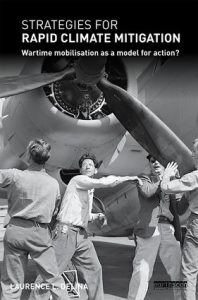We take our civilization for granted. But it’s fragile and pushing way beyond sustainable limits. How and why do civilizations collapse? In this program, we’ll hear from specialists who studied the end times of the Indus civilization of India and Pakistan, and the Maya of Central America. Then we’ll wrap up with a tough solution for our tough problems: a new book outlines how we could use World War Two style mobilization to save the climate and the ecosphere from their developing collapse. Our three guests are Cameron Petrie, Takeshi Inomata, and Laurence Delina.
You are tuned to the Radio Ecoshock special on collapse – how, why, and how to avoid it. That’s three interviews. Let’s get going.
Download or listen to this program in CD Quality (57 MB) or Lo-Fi (14 MB)
CAMERON PETRIE – THE COLLAPSE OF THE INDUS CIVILIZATION
The history of human civilization is short. But scientists are exploring how people adapted, or collapsed, during earlier changes to their climate. That information could help us now, as we go into a rapid shift.
We’re going to go back about 5,000 years, toward the start of human organization. That’s when the Indus Civilization formed around the Indus River of northwest India and Pakistan. A new article in the journal Current Anthropology draws on studies by the Banaras Hindu University, and the University of Cambridge in the UK. We’ll talk with the lead author, Dr. Cameron Petrie from Cambridge’s Division of Archaeology. Educated at the University of Sydney, Dr. Petrie went on to specialize in the archaeology of India, Pakistan and Iran.

Dr. Cameron Petrie, Cambridge
Our interview is based on new science in this paper “Adaptation to Variable Environments, Resilience to Climate Change: Investigating land, water and settlement in Indus northwest India“. It was published in the journal “Current Anthropology” in February 2017. I think it’s an exciting look into the origins of civilization, and the way this early experiment in human organization failed. It’s now apparent that a shift in climate played a big part.
There’s a very good article about all this in this article published by the University of Cambridge Division of Archeology. As the article says:
“The Indus Civilization developed in a specific environmental context, where the winter and summer rainfall systems overlapped. There is now evidence to show that this region was subject to climate change during the period when the Indus Civilization was at its height (c.2500-1900 BC).”
Download or listen to this 24 minute interview with Cameron Petrie on Radio Ecoshock in CD Quality or Lo-Fi
One of the sure signs of climate collapse was the record of water levels in a nearby lake. That lake more or less vanished during a drought that lasted several hundred years. That can be validated by a method of comparing rainfall recorded in the dripping stalagmites in various caves in the Middle East.
Petrie and other scientists are following up with the “TwoRains project“, funded by the European Research Council in 2015 and running until 2020.
So it looks like there was no sudden war or event that ended the Indus civilization. The farmers there were very adaptable, but when the monsoons shifted for too long, they had to abandon their large buildings, and move somewhere else, likely further east into modern-day India. I wonder if California could also depopulate in the future, if a hundred year drought kills off large-scale agriculture there as the climate shifts. We don’t know, but we do know that kind of blow has fallen on civilizations in the past.
TAKESHI INOMATA – THE COLLAPSE OF THE MAYA
In our current hyper-modern civilization, a lot of people worry about collapse . They have different reasons why it could happen. One of the big debates is whether civilizations tend to break up quickly, or fade away slowly. This paper actually studies two periods of collapse: the “classic” civilization which broke up around AD 150-300, and the later civilization which collapsed around between 800 and 900 AD.
In each case, the cities emptied out, but there were two different results. After the first collapse, dynasties developed which became the rulers of the second Mayan civilization. But the second collapse never recovered – although the Mayan people still populate southern Mexico and Guatemala.
If the international order breaks down, or the grid fails for some reason, some of us hope for new local governments and greater freedom. Others fear the multi-billionaire families will continue as dynasties ruling during another Dark Age. This research into the Maya suggests it can go either way.
A series of papers over the last dozen years suggest a long-lasting drought created tensions that led to regional wars. Inomata and his team cited a half dozen climate-leaning studies in their paper references. Climate change was one factor that helped the Mayan civilization collapse, but it was not the sole driver. Wars and economic stress were also evident.
Our guide to the collapse of the Mayan civilization is one of the world’s experts. Takeshi Inomata is a Professor of Anthropology at the University of Arizona. He also has a Chair in Environment and Social Justice. Dr. Inomata has published books, popular articles, and many key papers on thousands of years of the Maya people.

Dr. Takeshi Inomata
Takeshi Inomata is the lead author of a new paper in the Proceedings of the National Academy of Sciences. It’s the most accurate yet on WHEN, and at what pace, social and economic upheaval happened in Mayan culture. That helps explain how this advanced civilization came apart, until the cities were abandoned.
We talk about the new paper titled “High-precision radiocarbon dating of political collapse and dynastic origins at the Maya site of Ceibal, Guatemala“. It was published Dec 19th, 2016 in the Proceedings of the National Academy of Sciences.
Download or listen to this 16 minute interview with Takeshi Inomata on Radio Ecoshock in CD Quality
One advance of this paper is the detail of the chronology established. Perhaps for the first time, we can see how collapse developed over time, as the Mayan civilization emerges from the fog.
Note that the principal Mayan city studied in this paper – Ceibal Guatemala – is not that far away from, the rebellious state of Chiapas Mexico. The Zapatista claimed links to the Mayan culture, although their famous leader Subcomandante Marcos was not Mayan.
OUR GUEST WROTE THE BOOK ON THE MAYA
Probably the best print guide to the Mayan civilization was written by Takeshi Inomata and Stephen D. Houston. It’s called “The Classic Maya” – available on Amazon or course, or here from the publisher.
This is more information from WIKIPEDIA on Mayan Civilization
“History
3.1 Preclassic period (c. 2000 BC – 250 AD)
3.2 Classic period (c. 250–900 AD)
3.3 Postclassic period (c. 950–1539 AD)
3.4 Contact period and Spanish conquest (1511–1697 AD)
3.5 Persistence of Maya culture
Mesoamerica was one of six cradles of civilization worldwide. The Mesoamerican area gave rise to a series of cultural developments that included complex societies, agriculture, cities, monumental architecture, writing, and calendrical systems. The set of traits shared by Mesoamerican cultures also included astronomical knowledge, blood and human sacrifice, and a cosmovision that viewed the world as divided into four divisions aligned with the cardinal directions, each with different attributes, and a three-way division of the world into the celestial realm, the earth, and the underworld.”
During the Mayan collapse around AD 800–950, Europe was also in a time of collapse, dispersed in Medieval kingdoms with a relatively strong Papacy. The Middle East and parts of Asia were in a time of empire, following the fast spread of Mohammedanism.
THE IMPACT OF CLIMATE CHANGE ON MAYAN COLLAPSE
Note that while this paper references changes in rainfall, other papers have suggested climate change played a more important role.
For example check out this article in BBC News
“There are abundant theories about what finished off the Maya. There are the old favourites – invasion, civil war, collapsing trade routes – but ever since the first Central American ancient climate records were pieced together in the early 1990s, one theory has become particularly popular: that the Maya civilization was ultimately doomed by a period of severe climate change.
In the centuries immediately before the Maya collapse – the so-called “Classical Age” between about AD250 and 800 – the civilization boomed. Cities flourished and harvests were good. Climate records (which mostly come from the analysis of cave formations) show that during this time the Maya area had received relatively high rainfall. But the same records show that, starting in about AD820, the region was ravaged by 95 years of punctuated droughts, some of which lasted for decades.”
That article references a different study:
“The political collapse of Chichén Itzá in climatic and cultural context” – Julie A. Hoggarth, published in Global and Planetary Change, March 2016.
Takeshi Inomata et al do say:
“These major waves of political disintegration in both the Preclassic and Classic collapses may have corresponded with prolonged droughts, which may have exacerbated deteriorating social conditions.”
LAURENCE DELINA: WWII-STYLE MOBILIZATION TO SAVE THE CLIMATE
Scientists and pundits suggest we need World War Two style mobilization to fight climate change. But what will it really take? If we had the will to save ourselves from devastating climate change, what could we do? That’s the task of a new textbook from Dr. Laurence L. Delina. He’s a Postdoctoral Associate at The Frederick S. Pardee Center for the Study of the Longer-Range Future. That’s at Boston University. Laurence is also the Rachel Carson Fellow at LMU University in Germany. I reached Laurence in Munich.
We talk about the new book “Strategies for Rapid Climate Mitigation Wartime mobilization as a model for action?” Note there is a question mark at the end of that title. The book explores what could work, IF world governments decide for action.

The book comes with a foreword by one of my climate heroes, Dr. Hans Joachim (John) Schellnhuber. Early on, Schellnhuber dared to ask the question: what if we go beyond 4 degrees C of heating? There were two conferences on that. The first was at Oxford I believe. I broadcast Shellnhuber’s speech from the second, held in Australia in September 2009. Find that program here, and my detailed notes on his speech here.
Download or listen to this 20 minute interview with Laurence Delina on Radio Ecoshock in CD Quality or Lo-Fi
You may also be interested in a paper Laurence co-authored last year: “Strengthening the climate action movement“. That is a whole other interview.
WRAPPING UP
We are out of time, for this show and for the environment where we were born. Pass it on please, by sharing this program or this blog through your social media channels.
If you are able to help me keep producing Radio Ecoshock, I need that help. You can sign up for a monthly donation, or make a one-time donation of any amount, on this page.
I’m Alex Smith. Thank you for listening, and caring about our world.
So, I really want to commend you on the interview concerning “rationing of consumer goods”…. This… is…. the way to go. We are such a spoiled bunch… professional sports… and all our luxury items… we do not focus on necessities of life…. we focus on fun, excess, macho crap…and extreme comfort. It’s one thing to have some heat… it’s another to make an indoor beach. I am extremely upset that our species doesn’t see the error of our ways. Even those who should… know better…are not speaking up about our excess… that is a big answer to our problem. We still do not understand that this is a big answer to our way out of this mess. The next, is to shut down ALL NUCLEAR POWER PLANTS. If we start now, we might be able to bring them down far enough within the next 40 years to make them unable to end life on the planet. Maybe you can have a show on just that.
Agree absolutely. We consume too much junk. Women especially. Nowhere on the MSM do we talk about this.Yes, and get rid of nuclear power plants. Look at the ongoing tragedy of Fukushima – again largely ignored by the MSM . But even as we speak, new reactors are being built.